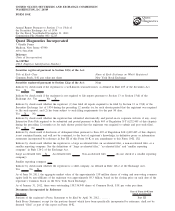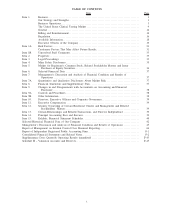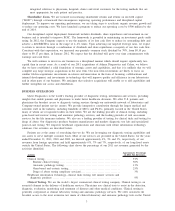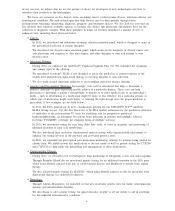Quest Diagnostics 2011 Annual Report Download - page 12
Download and view the complete annual report
Please find page 12 of the 2011 Quest Diagnostics annual report below. You can navigate through the pages in the report by either clicking on the pages listed below, or by using the keyword search tool below to find specific information within the annual report.
of test services, we believe that we are the partner of choice for developers of new technologies and tests to
introduce their products to the marketplace.
We focus our resources on key disease states, including cancer, cardiovascular disease, infectious disease and
neurological conditions. We seek technologies that help doctors care for their patients through better
predisposition, screening, monitoring, diagnosis, prognosis and treatment choices. We also look for tests that are
less invasive than currently available options, to increase the choices that physicians and patients have for the
collection of diagnostic samples. With these priorities in mind, we recently introduced a number of new or
enhanced tests, including those discussed below.
•Cancer.
- In 2011, we introduced our melanoma treatment selection mutation panel, which is designed to assist in
the personalized selection of patient therapies.
- We introduced our thyroid cancer mutation panel, which assists in the diagnosis of thyroid cancer and
aids physicians and surgeons as they plan surgery and other therapies to treat and attempt to cure
thyroid cancer.
•Infectious Disease.
- During 2011, we enhanced our SureSwab威Vaginosis/Vaginitis Plus test. We expanded the organisms
and sample types in the offering.
- We introduced Accutype威IL28b, a test designed to aid in the prediction of patient response to the
widely-used peginterferon alpha-based therapy for treating hepatitis C virus infection.
- We also made several important additions to our transplant infectious disease offering.
•Genetics and Personalized Medicine. Increasingly, tests will be introduced that help to determine a
patient’s genotype or gene expression profile relative to a particular disease. These tests can help
physicians to determine a patient’s susceptibility to disease or to tailor medical care to an individual’s
needs – such as determining if a medication might be more or less effective for a particular person, or
which type of medication might work better, or tailoring the right dosage once the proper medicine is
prescribed. A few examples are set forth below:
- In 2012, the FDA granted our de novo classification petition for our STRATIFY JCVTM Antibody
ELISA testing service. It is the first blood test to be FDA market authorized for the qualitative detection
of antibodies to the polyomavirus JC virus for stratifying risk for progressive multifocal
leukoencephalopathy, an infrequent but serious brain infection, in patients with multiple sclerosis
receiving TYSABRI威, a therapy for relapsing forms of multiple sclerosis.
- In 2011, we introduced testing for very long chain fatty acids, to assist in diagnosis and monitoring of
inherited disorders of fatty acid metabolism.
- We also introduced high resolution chromosomal analysis testing with oligonucleotide microarrays to
enhance our testing services in the pre-natal and post-natal genetics areas.
- In 2011, we expanded our prescription pain medication monitoring offering for patients being treated for
chronic pain. We added several key medications to the test menu as well as genetic testing for CYP2D6
and CYP2C19 to help guide the prescribing and management of these medications.
•Cardiovascular Disease.
- During 2011, we released a test for therapeutic drug monitoring of dabigatran, a new oral anti-coagulant.
- Through Berkeley HeartLabs we introduced genetic testing for an additional mutation in the LPA gene
which helps identify patients with risk of cardiovascular disease and likelihood to benefit from aspirin
therapy.
- We also released genetic testing for SLC01B1, which helps identify patients at risk for myopathy from
Simvastatin therapy for cholesterol reduction.
•Neurology.
- Through Athena Diagnostics, we launched several new molecular genetic tests for stroke, neuromuscular
diseases and mitochondrial disorders.
- We also began to offer genetic testing for spinal muscular atrophy to all our clients to aid in screening
for this inherited neuromuscular condition.
6
























